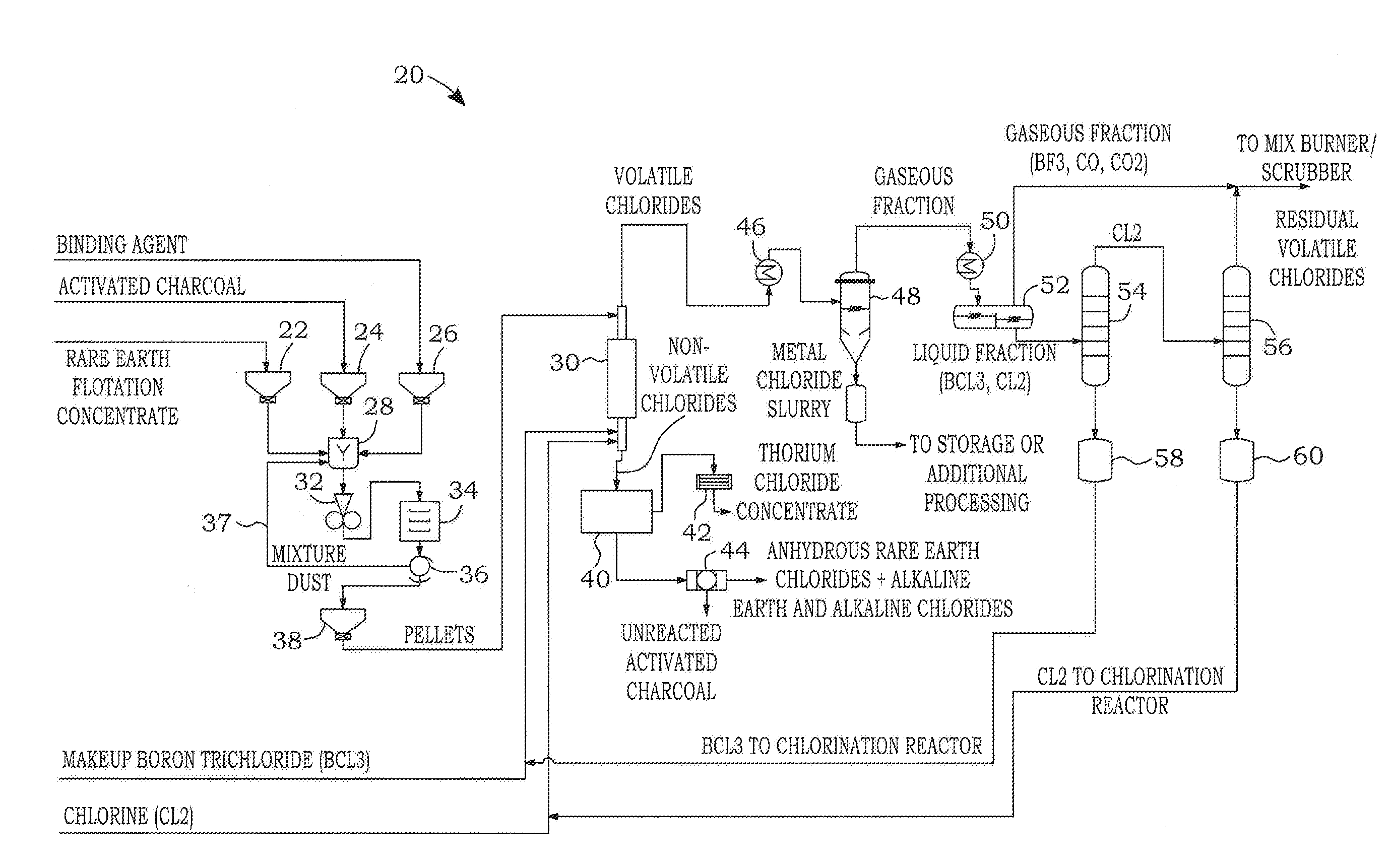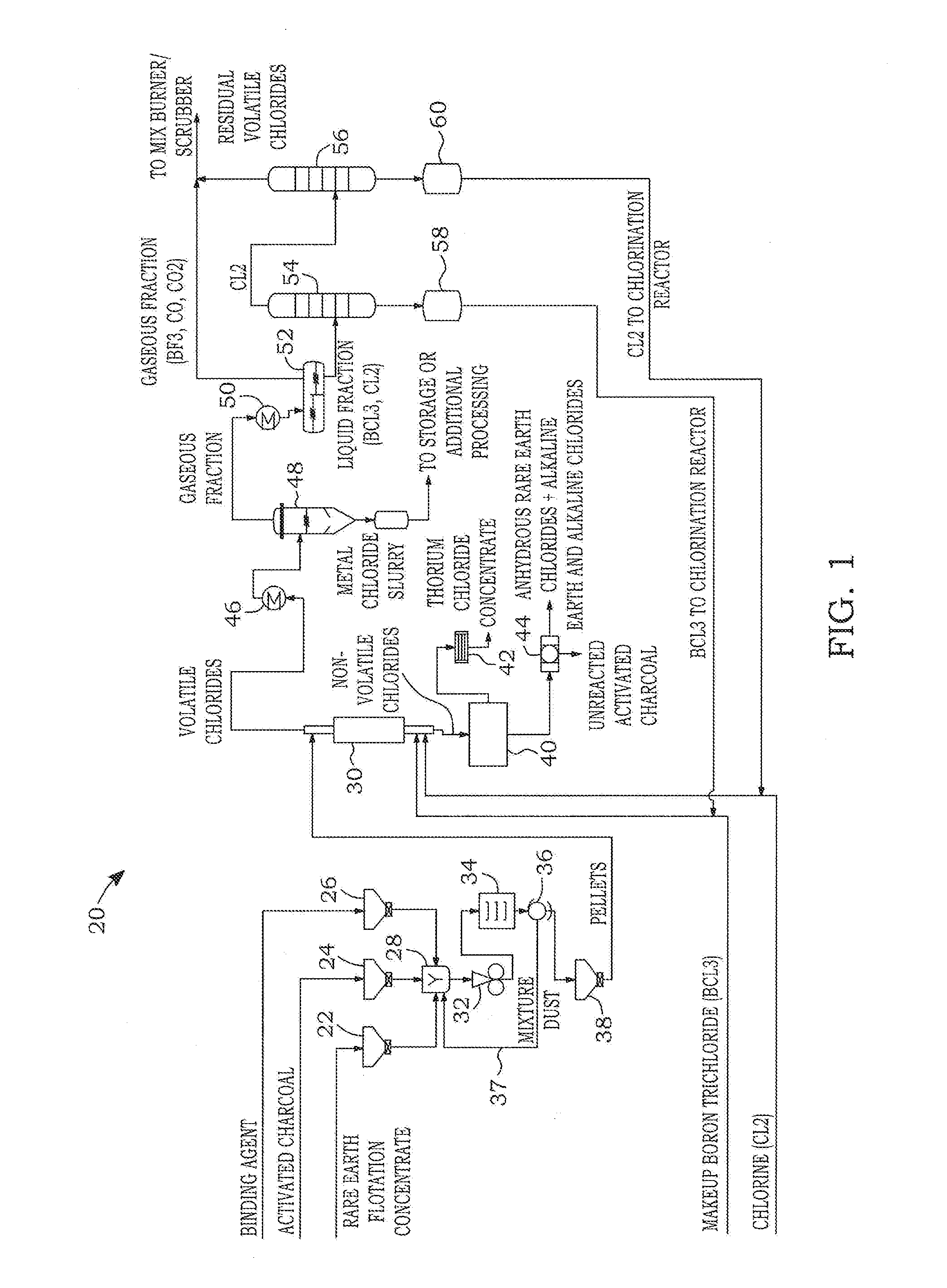Dry chlorination process to produce anhydrous rare earth chlorides
a rare earth chloride and chlorination process technology, applied in the field of rare earth chloride production process, can solve the problems of large blockage of piping, poor reaction efficiency at high temperature, and inapplicability of chlorination experiments and results to bastnaesite and bastnaesite/monazite mixed concentrates
- Summary
- Abstract
- Description
- Claims
- Application Information
AI Technical Summary
Benefits of technology
Problems solved by technology
Method used
Image
Examples
example 1
Testing the Effect of the Lewis-Acid Addition on the Chlorination Reaction of Mixed Bastnaesite and Monazite Concentrate
[0106]The theoretical basis of the chlorination process was described in detail above including the effect of a Lewis acid addition on the dry chlorination reaction. Prior art showed that a chlorination time of at least two (2) hours was necessary to achieve good conversion rates of rare earths into chlorides for chlorination processes on mixed Bastnaesite and Monazite concentrates without a Lewis acid addition. Hence, Wang et al. (Wang, Z. C., Zhang, Li-Q., Lei, P. X., Chi, M., 2002., Metallurgical and Materials Transactions B. Vol. 33B, pp. 661-668) have obtained a conversion rate in the order of 75 wt % for a carbochlorination experiment wherein the reactant consists of Cl2 plus activated charcoal, at a reaction temperature of 600° C. for two (2) hours on a mixed Bastnaesite and Monazite flotation concentrate. According to their data, after 30 minutes of carboch...
example 2
Testing the Effect of a Variation of the Concentrate / Carbonaceous Reducer Ratio
[0111]One of the parameters controlling the chlorination reaction speed is the time required by the gaseous reactants to reach the surface of the feed material to be chlorinated. The gaseous reactants move by diffusion through the solid bed, including the feed material, the binder, and the solid carbonaceous reducer, if any. Increasing quantities of solid carbonaceous reducer for a predetermined mass of feed material produces an increased solid bed mass to be chlorinated. This can be assimilated to a > expanding the distance between each of the mineral grains to be chlorinated. In order to evaluate the > created by the solid carbonaceous reducer, a series of experiments was conducted by fixing the mass of the rare earth concentrate and modifying the quantity of solid carbonaceous reducer added to the rare earth concentrate. It is not possible to calculate a stoichiometric quantity of carbon required to fi...
example 3
Testing the Replacement of a Solid Carbonaceous Reducer by a Gaseous Carbonaceous Reducer
[0114]In the below described tests, the solid carbonaceous reducer in the reactants was replaced by a gaseous carbonaceous reducer and, more particularly, carbon monoxide (CO). The presence of the solid carbonaceous reducer in the reaction products present in the vessel at the end of the chlorination reaction resulted in a solid mixture containing the chloride salts and the solid carbonaceous reducer. It is known that the solid reducer might interfere in subsequent rare earth separation processes such as fused salt electrolysis. Hartley and Willy (Hartley, F. R. and Wylie, A. W., 1950, Journal of the Society of Chemical Industry, vol. 69, no. 1, pp. 1-7) tested the replacement of the solid carbonaceous reducer with CO in the chlorination of a Monazite concentrate. Their results indicated a conversion of only 30 wt % of rare earths after a chlorination period of 3.5 hours at temperatures of 750° ...
PUM
| Property | Measurement | Unit |
|---|---|---|
| temperature | aaaaa | aaaaa |
| temperature | aaaaa | aaaaa |
| diameter | aaaaa | aaaaa |
Abstract
Description
Claims
Application Information
 Login to View More
Login to View More - R&D
- Intellectual Property
- Life Sciences
- Materials
- Tech Scout
- Unparalleled Data Quality
- Higher Quality Content
- 60% Fewer Hallucinations
Browse by: Latest US Patents, China's latest patents, Technical Efficacy Thesaurus, Application Domain, Technology Topic, Popular Technical Reports.
© 2025 PatSnap. All rights reserved.Legal|Privacy policy|Modern Slavery Act Transparency Statement|Sitemap|About US| Contact US: help@patsnap.com



